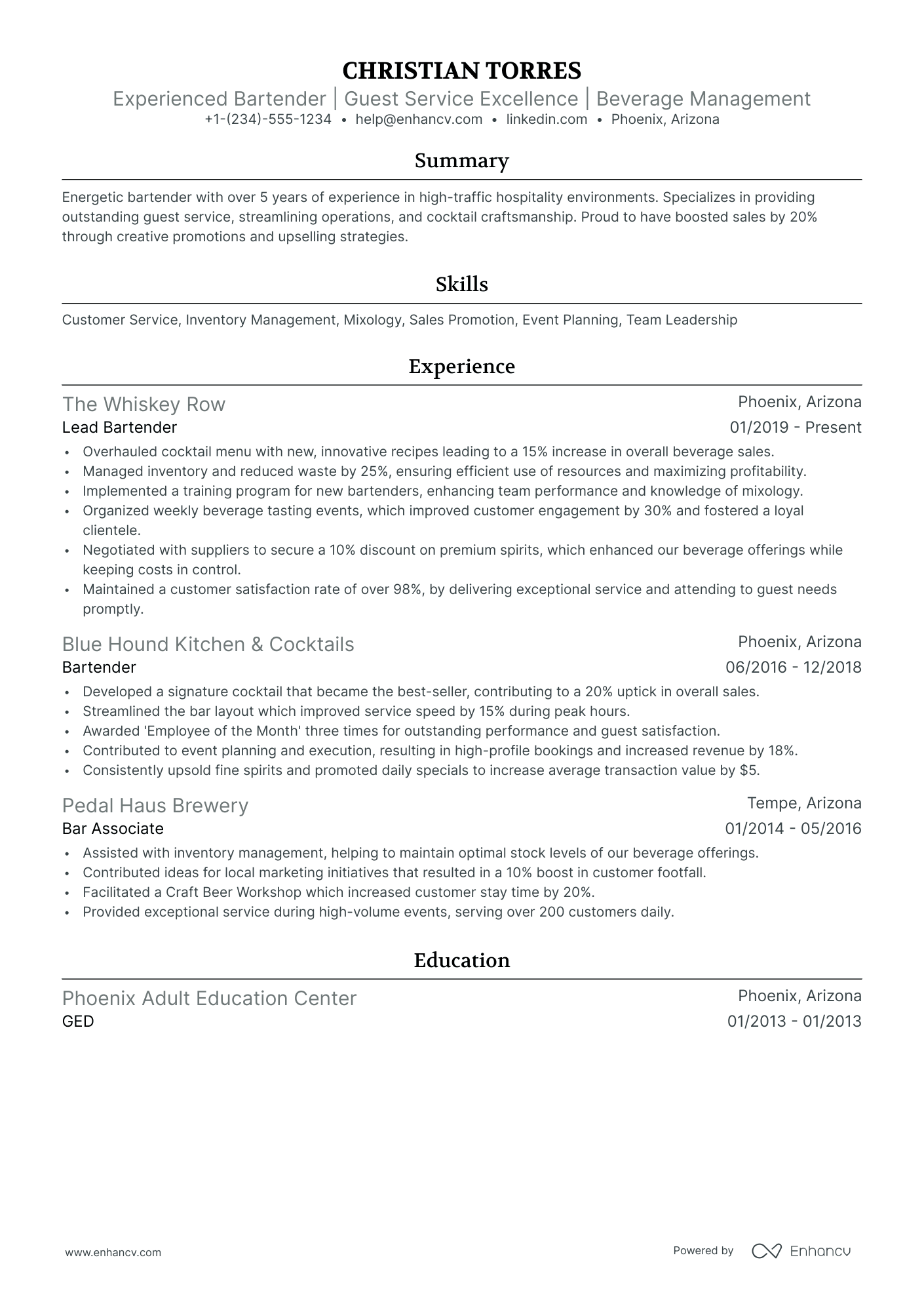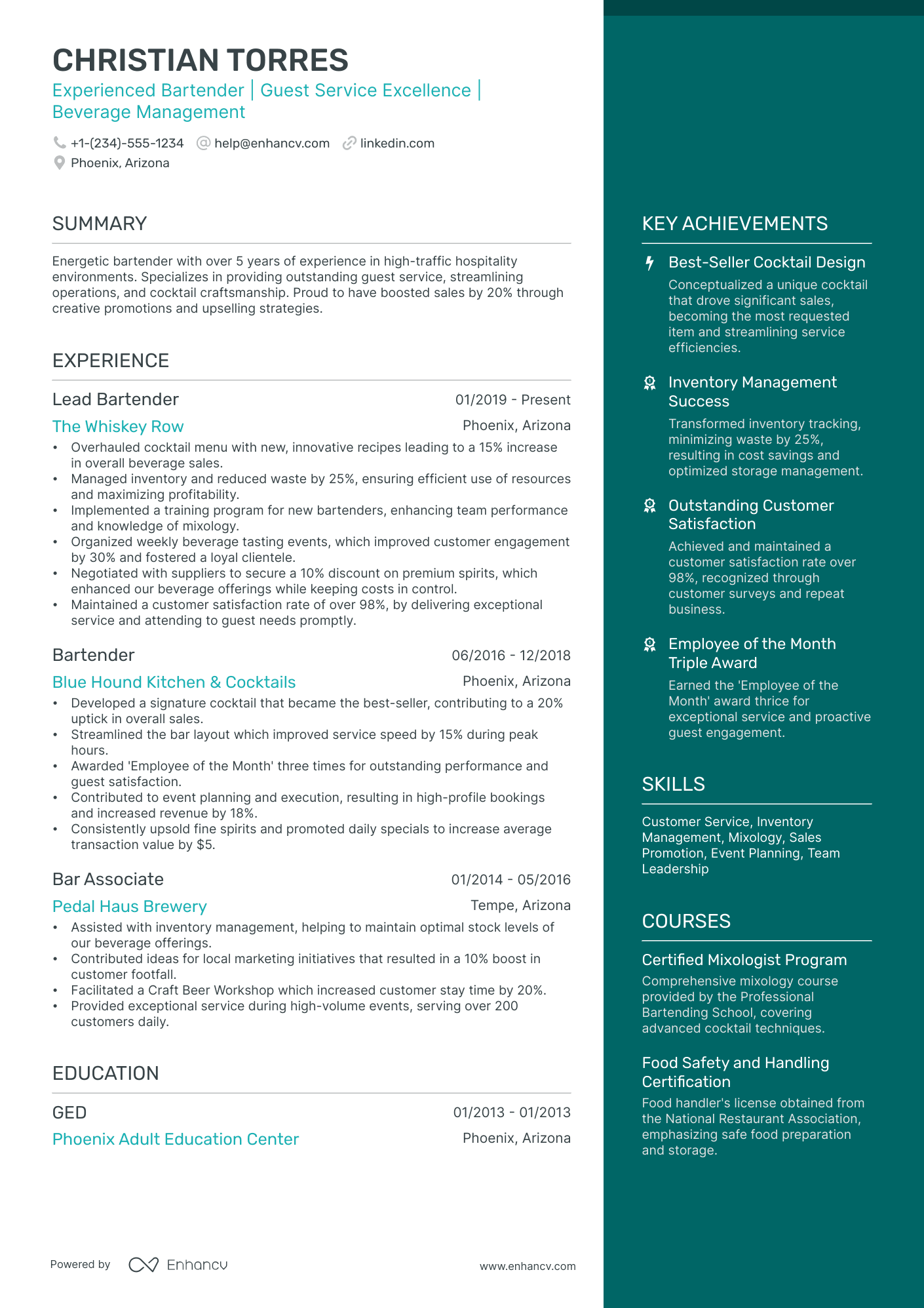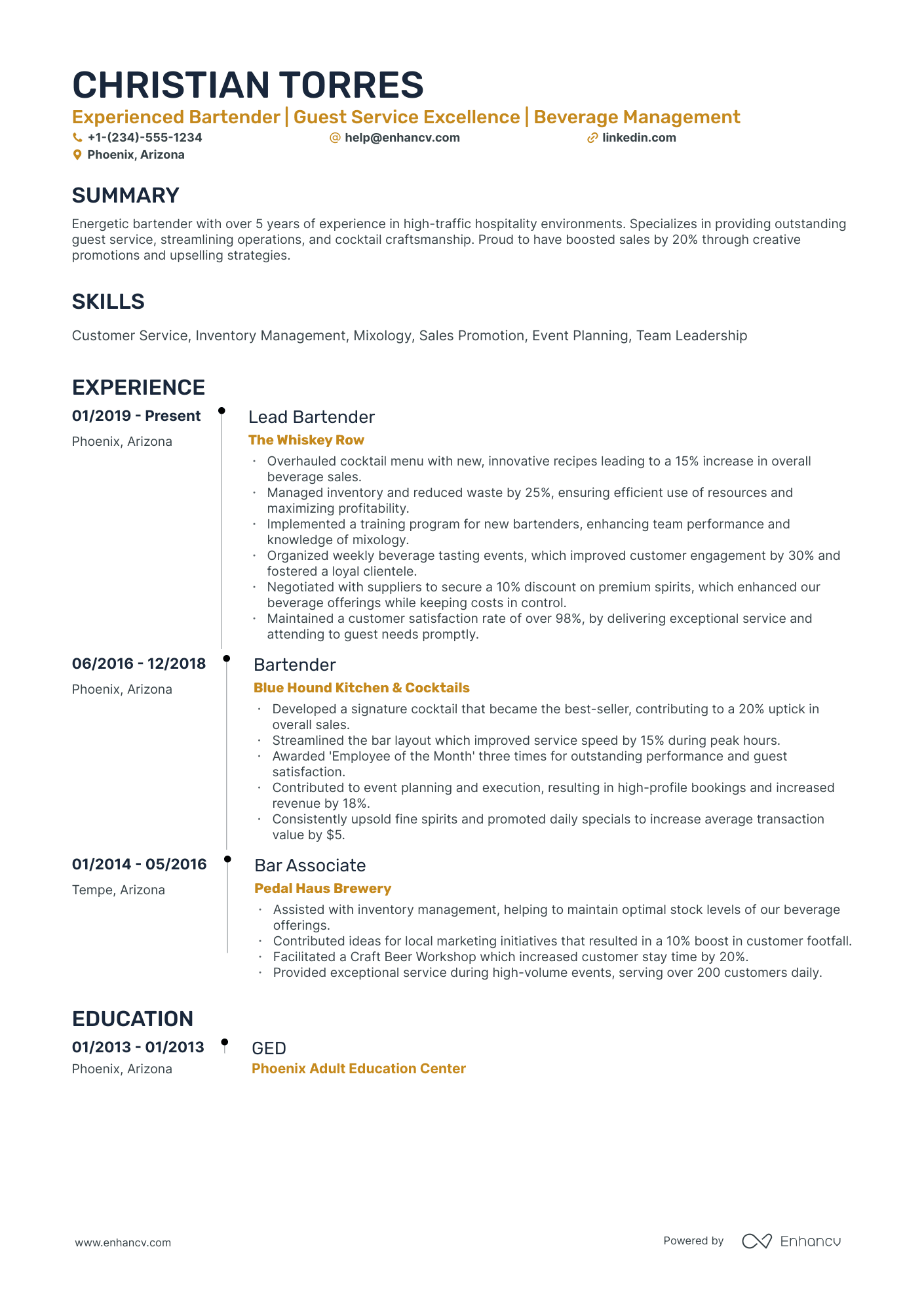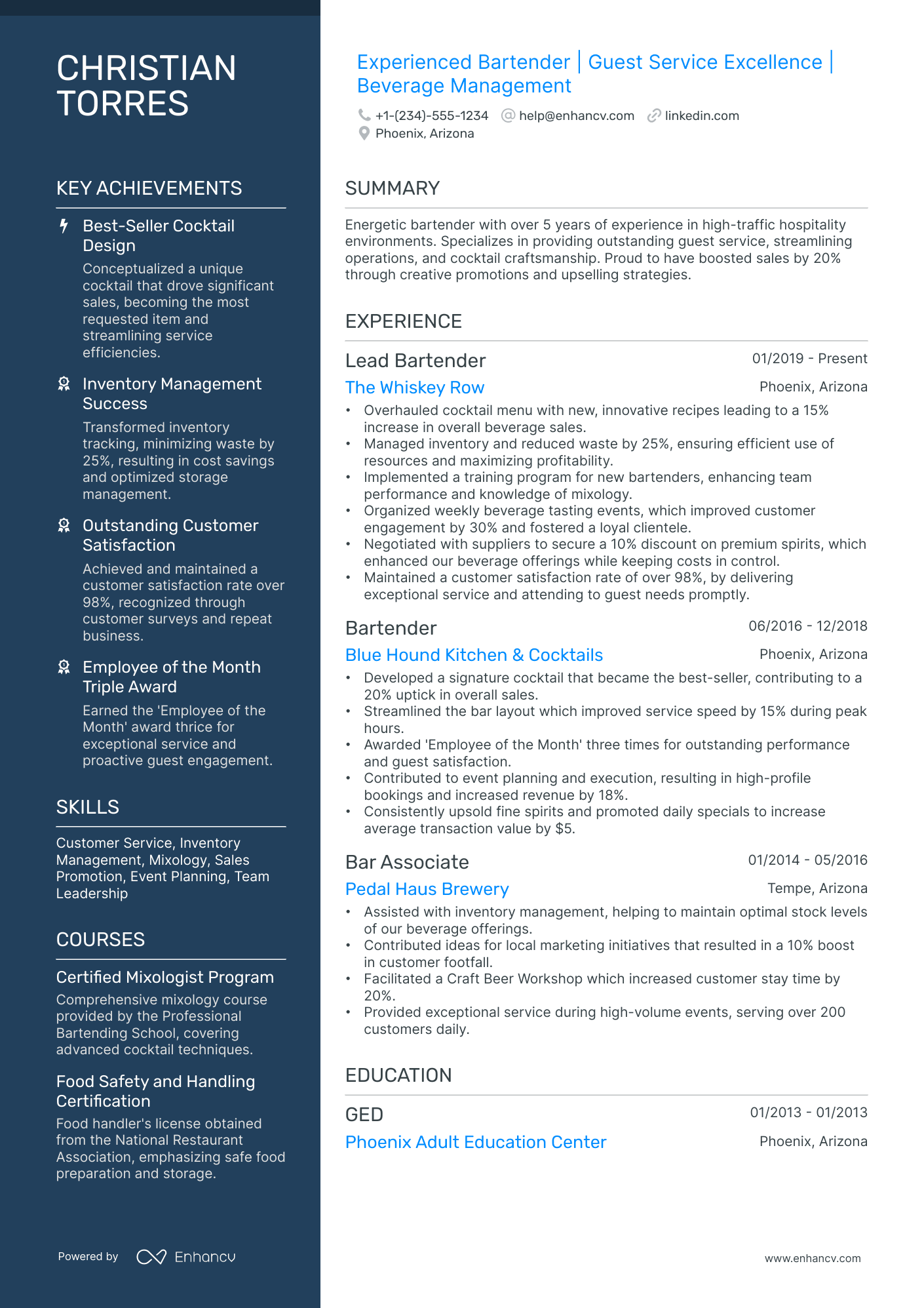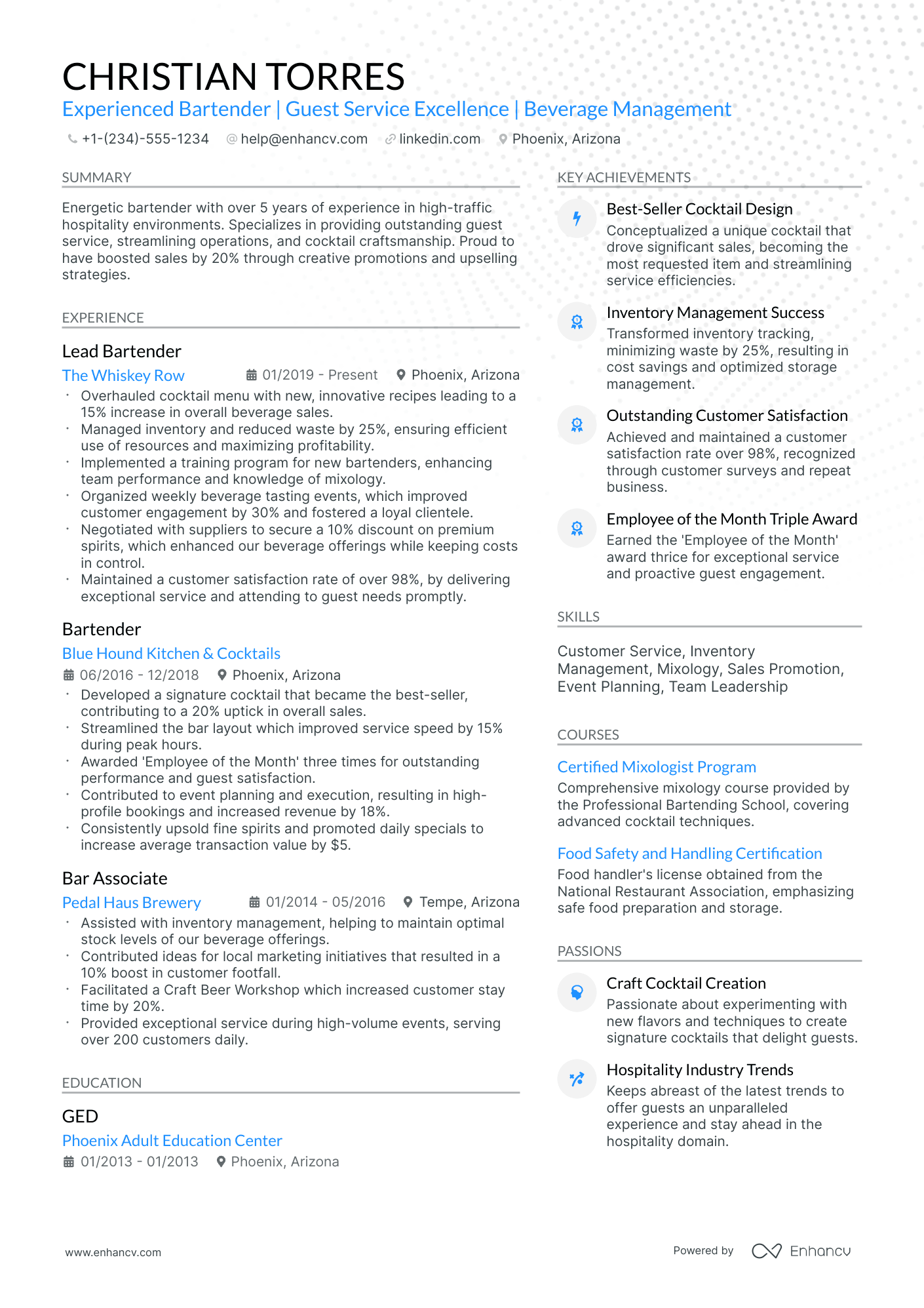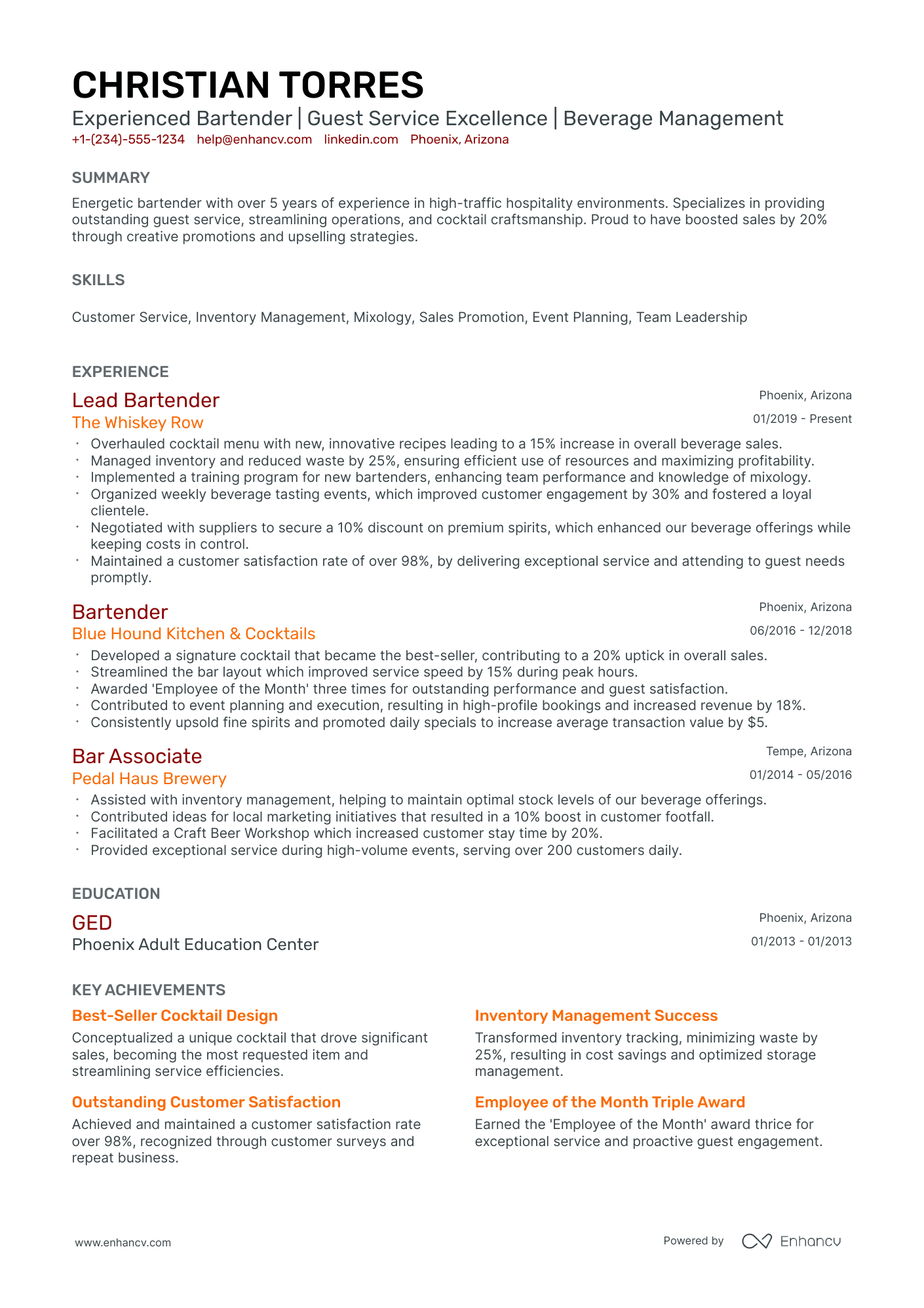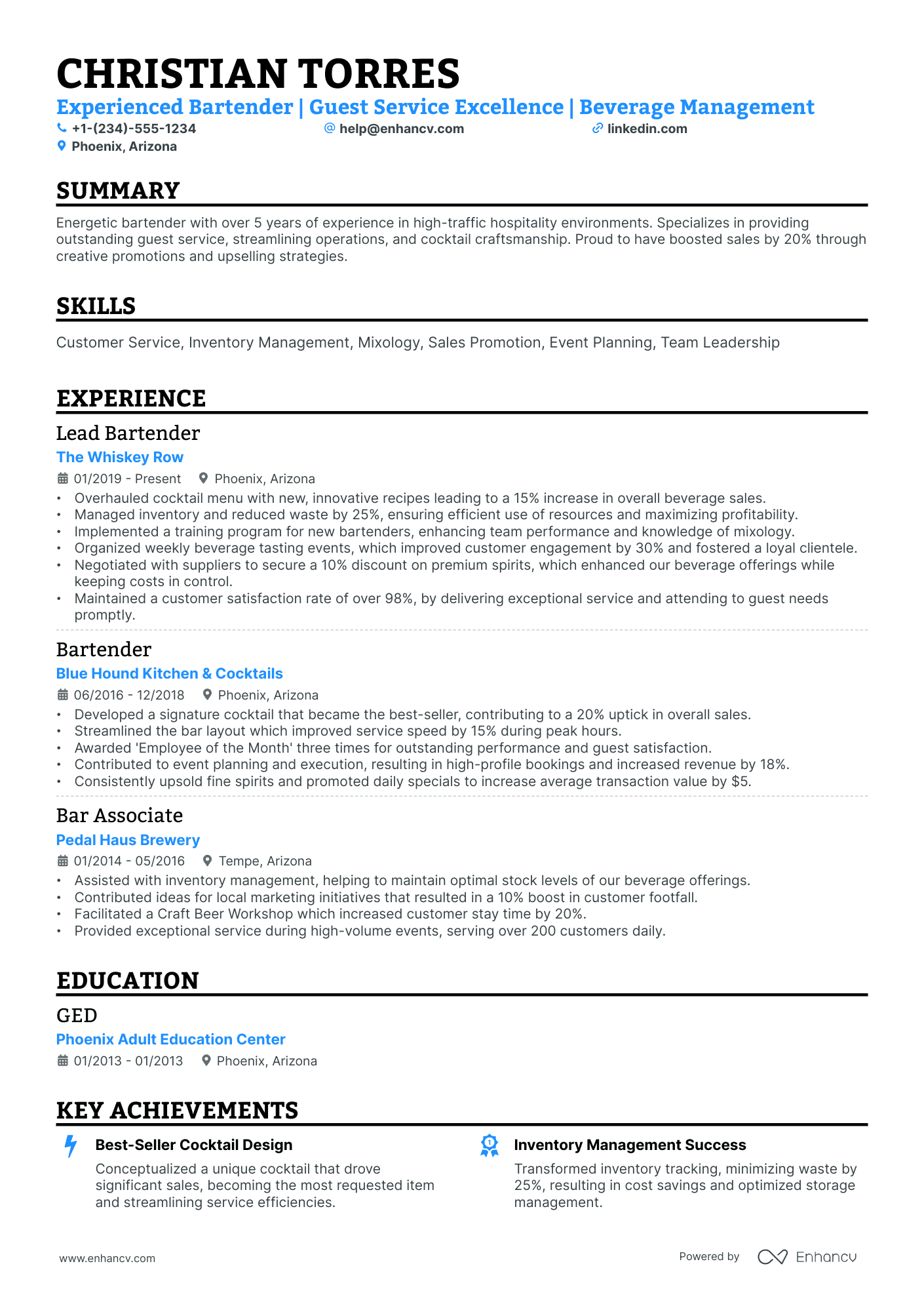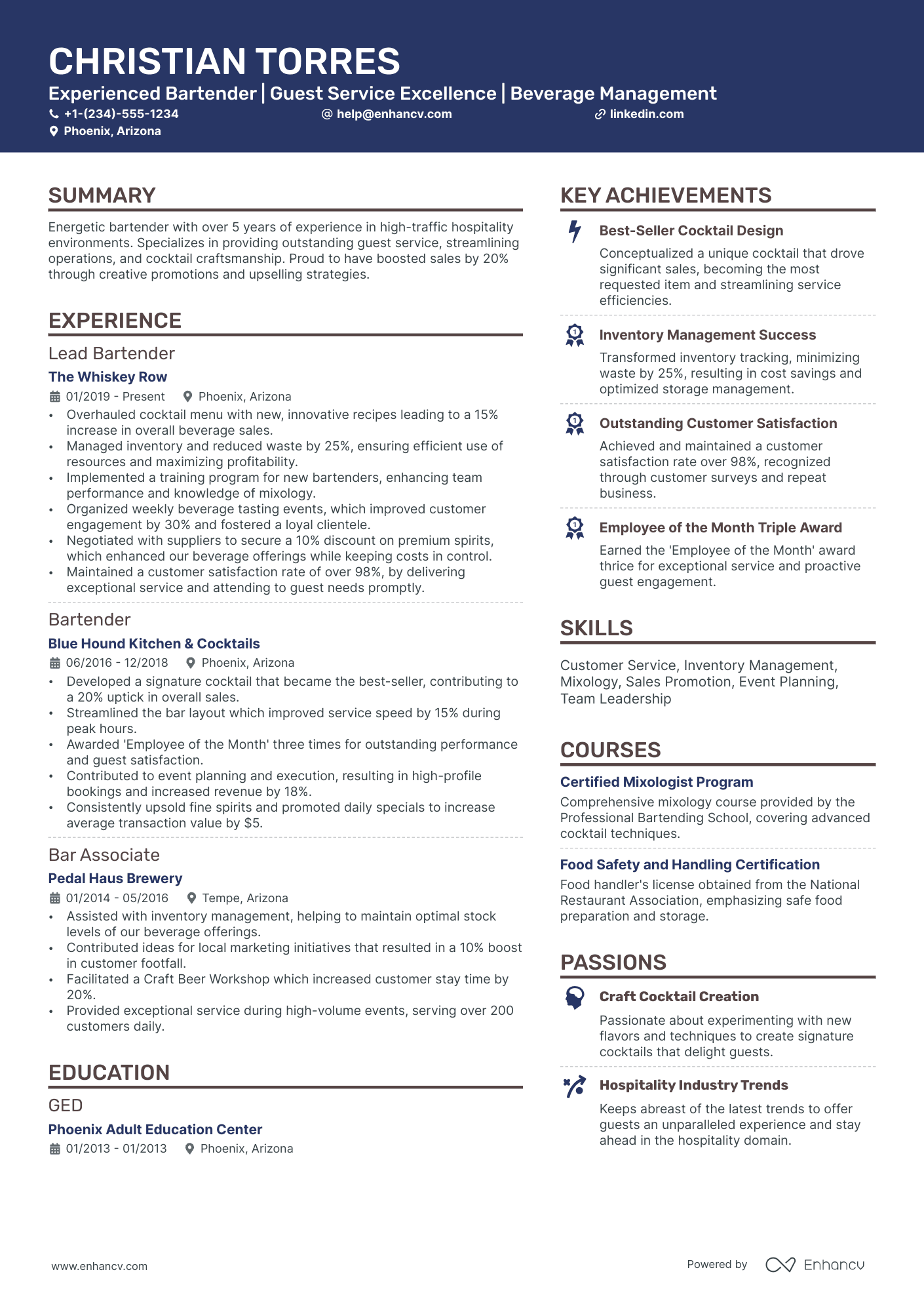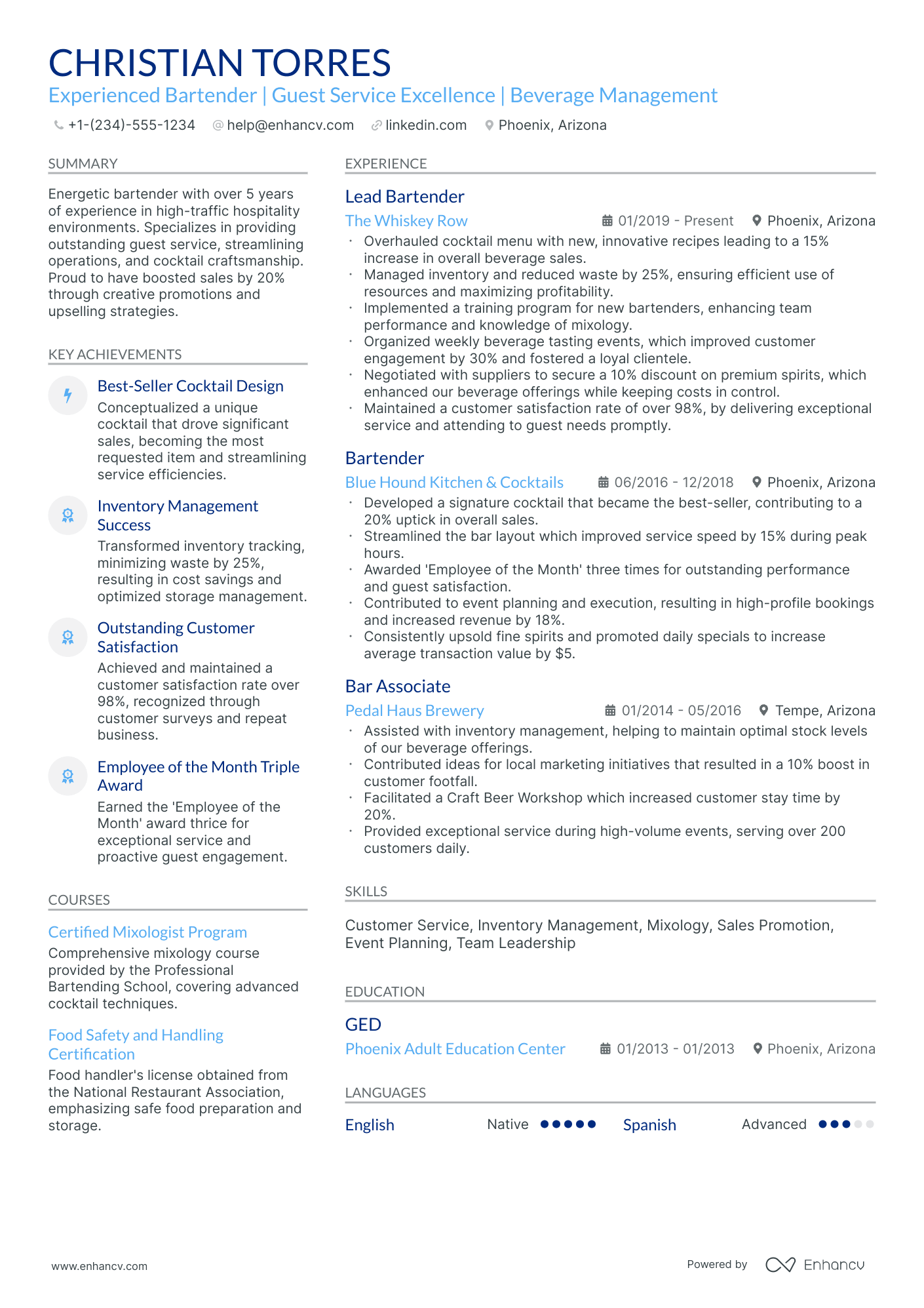One resume challenge you may face as a hotel bartender is highlighting your multitasking skills in a way that sets you apart from other candidates. Our guide can provide you with industry-specific language and examples to showcase your ability to efficiently manage a high-volume bar, ensuring your resume resonates with hospitality recruiters.
- Aligning the top one-third of your hotel bartender resume with the role you're applying for.
- Curating your specific hotel bartender experience to get the attention of recruiters.
- How to list your relevant education to impress hiring managers recruiting for the hotel bartender role.
Discover more hotel bartender professional examples to help you write a job-winning resume.
Don't stress out over your hotel bartender resume format
Remember, the elaborate design of your hotel bartender resume isn't what impresses recruiters most. They are primarily searching for candidates who meet the job requirements. The main aim of your resume should be to clearly and concisely explain why employers should hire you.
Here are four straightforward steps to consider in your hotel bartender resume design:
- Organize your resume based on experience: Start with your most recent roles. Besides using reverse chronological order, choose jobs relevant to the position you're applying for.
- Include your contact details (and portfolio or LinkedIn link) in your resume's header to ensure recruiters can easily reach you. If considering adding a professional photo, check acceptable practices in different countries first.
- Don't omit essential hotel bartender resume sections such as the summary or objective, experience, and education. These sections should reflect your career progression and align with job requirements.
- Maintain conciseness in your resume. For those with less than ten years of experience, a one-page format is advisable.
Regarding the format to submit your hotel bartender resume, PDF is preferable. PDFs are more likely to maintain their formatting when processed through recruitment software or ATS, saving you time in the application process.
When selecting a font for your hotel bartender resume, consider the following:
- Choose ATS-friendly fonts such as Exo 2, Volkhov, Lato, etc., to keep your resume's content legible;
- All serif and sans-serif fonts are easily readable by ATS;
- While Arial and Times New Roman are common choices, opting for unique typography can help your resume stand out.
Concerned about ATS compatibility with charts and infographics? Our recent study has debunked this and other myths.
Adjust your resume layout based on the market – Canadian resumes, for example, may follow a unique format.
Upload & Check Your Resume
Drop your resume here or choose a file. PDF & DOCX only. Max 2MB file size.
PRO TIP
Bold the names of educational institutions and certifying bodies for emphasis.
Hotel bartender resume sections to answer recruiters' checklists:
- Header to help recruiters quickly allocate your contact details and have a glimpse over your most recent portfolio of work
- Summary or objective to provide an overview of your career highlights, dreams, and goals
- Experience to align with job requirements and showcase your measurable impact and accomplishments
- Skills section/-s to pinpoint your full breadth of expertise and talents as a candidate for the hotel bartender role
- Education and certifications sections to potentially fill in any gaps in your experience and show your commitment to the industry
What recruiters want to see on your resume:
- Proficiency in mixing, garnishing, and serving drinks according to established recipes and bar standards
- Knowledge of local, state, and federal regulations regarding the service of alcohol and health code compliance
- Customer service skills and the ability to engage with guests to create a memorable experience
- Experience in inventory management, ordering supplies, and maintaining bar equipment
- Ability to handle high volume situations with efficiency and a calm demeanor
What is the resume experience section and how to write one for your past roles
The experience section in a hotel bartender resume is critical for your profile and overall application. It should not only display your work history, but also highlight your achievements in previous roles.
Many candidates either simply list their duties or provide excessive details about past, irrelevant jobs. A more effective approach involves first examining the job advertisement for keywords - specifically, skills essential for the role. Then, demonstrate these key requirements throughout different parts of your resume, using accomplishments from your roles.
Format each bullet point in your experience section by starting with a strong action verb. Follow this with a description of your role and its impact on the team or organization.
Aim to include three to five bullet points for each role.
Finally, gain insights into how professionals have crafted their hotel bartender resume experience sections by exploring some best practice examples.
- Efficiently managed a high-volume drink station at the Marriott, serving an average of 150 patrons per night with a keen focus on high-quality cocktail preparation.
- Collaborated with the restaurant team to create a 'Cocktail of the Month', boosting beverage sales by 25% by leveraging local seasonal ingredients.
- Implemented inventory tracking improvements that reduced waste by 20% through meticulous monitoring and analysis of stock levels.
- Pioneered a signature cocktail menu for Hilton's lobby bar that increased drink revenue by 35% due to popular demand and repeat customers.
- Conducted weekly mixology workshops for staff, enhancing team's skill set and enabling them to deliver a diverse range of high-quality beverages.
- Orchestrated a successful wine and spirits tasting event that attracted 200+ guests, resulting in a 15% increase in premium wine sales.
- Managed a dynamic team of 10 bartenders at Hyatt Regency, consistently receiving accolades for outstanding customer service and satisfaction.
- Implemented a dynamic pricing strategy for happy hours and special events, leading to an 18% uplift in overall beverage profit margins.
- Facilitated cross-training between the bar and kitchen staff, fostering teamwork and providing a comprehensive customer service experience.
- Curated an extensive craft cocktail program at The Ritz-Carlton, distinguishing the establishment as a top destination for unique beverage experiences in the city.
- Negotiated with vendors to secure premium ingredients at a 10% cost reduction, allowing for higher profit margins without sacrificing quality.
- Championed a sustainability initiative that incorporated organic, local produce in all cocktails, gaining media attention and enhancing brand image.
- Oversee a sophisticated urban bar at the W Hotel, delivering an immersive cocktail experience that has seen a year-over-year revenue increase of 20%.
- Develop a comprehensive training program for new bartenders, resulting in a 40% decrease in onboarding time and a uniformity in drink quality.
- Coordinate with event planners to offer customized bar services for weddings and corporate events, which now represent a 30% share of the bar's business.
- Served as a resident mixologist at Four Seasons, becoming the go-to expert for drink pairing during gourmet dining events and private parties.
- Achieved a record-setting sale of high-end spirits, contributing to a 50% increase in the bar's luxury spirit sales within a year.
- Coordinated with kitchen staff to develop a harmonized food and cocktail menu that enhanced the dining experience and increased average customer spend by 20%.
- Demonstrated exceptional knowledge of wine and spirits at The Peninsula Hotel, which allowed for personalized guest interactions and recommendations that improved guest satisfaction scores by 30%.
- Initiated an upscale bar lounge concept that drew in a high-net-worth clientele, resulting in an increase in average check size by 40%.
- Managed bar operations during high-profile events, maintaining superb service standards despite serving over 300 guests per event.
- Designed an innovative cocktail program at the InterContinental, incorporating modern techniques such as spherification and foam infusions that differentiated the menu from competitors.
- Drove a customer loyalty program that accounted for a 25% increase in repeat clientele, through a combination of creative promotions and personalized service.
- Oversaw the bar's financial management, consistently staying under budget by 15% through strategic cost control and efficient use of resources.
Quantifying impact on your resume
- Track and report the number of drinks served nightly to showcase high-volume service capabilities.
- Document the percentage increase in bar revenue following the introduction of new cocktail menus to demonstrate innovative selling skills.
- Record the number of upsold premium spirits and wines to reflect persuasive salesmanship.
- Maintain accurate inventory counts to illustrate meticulous attention to detail and loss prevention skills.
- Note the percentage of customer service commendations to demonstrate excellence in guest relations.
- Calculate the reduction of waste through efficient stock management, showing a commitment to cost-saving practices.
- Track the number of training sessions conducted for new staff to highlight leadership and mentoring abilities.
- Report on the consistency of health and safety audit scores to show a commitment to maintaining high standards.
Action verbs for your hotel bartender resume
What can candidates do about their resume, if they have no experience
Job requirements can sometimes be answered by other elements you could make more prominent in your hotel bartender resume.
Thus, you'd be substituting your lack of experience with your relevant:
- Education with details of skills you've obtained that align with the job
- Internships and short-term jobs that are once more dedicated to putting your expertise in the spotlight
- Skills section answering basic and - potentially - more specific job qualifications
- Strengths or accomplishments to show the unique value you present, even as a candidate with less or no professional experience in the industry.
Recommended reads:
PRO TIP
Highlight any significant extracurricular activities that demonstrate valuable skills or leadership.
Key hard skills and soft skills for your hotel bartender resume
At the top of any recruiter hotel bartender checklist, you'd discover a list of technical competencies, balanced with personal skills.
Hard or technical skills are your opportunity to show how you meet the essential responsibilities of the role. The ability to use a particular job-crucial technology or software would also hint to recruiters whether you'd need a prolonged period of on-the-job training - or you'd fit right in the job.
But to land your dream role, you'd also need to demonstrate a variety of soft or people resume skills . Employers care about soft skills as they show how each candidate would fit into the team and company culture.
Both types of skills are specific and to best curate them on your resume, you'd need to:
- Create a skill section within which you showcase your hard and soft skills and present how they help you succeed.
- List specific examples of projects, tasks, or competitions, within which your skill set has assisted your results.
- Soft skills are harder to measure, so think about situations in which they've helped you thrive. Describe those situations concisely, focusing on how the outcome has helped you grow as a professional.
- Metrics of success - like positive ROI or optimized workplace processes - are the best way to prove your technical and people skills.
Take a look at some of hotel bartender industry leaders' favorite hard skills and soft skills, as listed on their resumes.
Top skills for your hotel bartender resume:
Mixology
Cocktail Preparation
Bar Equipment Operation
Inventory Management Software
POS Systems
Glassware Identification
Beverage Menu Development
Drink Garnishing Techniques
Knowledge of Alcohol Laws
Cash Handling
Customer Service
Communication
Multitasking
Attention to Detail
Teamwork
Time Management
Problem Solving
Adaptability
Conflict Resolution
Creativity
PRO TIP
Listing your relevant degrees or certificates on your hotel bartender resume is a win-win situation. Not only does it hint at your technical capabilities in the industry, but an array of soft skills, like perseverance, adaptability, and motivation.
What are the best certificates to add to your hotel bartender resume + how to curate your education section
The education and certification resume sections are the underdogs of your hotel bartender resume.
They showcase to recruiters that you've invested plenty of time to gain valuable and specific know-how, vital for growth.
As far as the resume education section is concerned:
- Detail only advanced education, specifying the institution and timeframe.
- Indicate your forthcoming graduation date if you're in the midst of your studies.
- Consider omitting degrees that don't align with the job's requirements.
- Offer a description of your academic journey if it underscores your notable achievements.
When curating your degrees and certificates on your hotel bartender resume:
- Select only accreditation that matters to the role
- Niche knowledge that could help you stand out as a candidate (as is within the past few years), should be listed towards the top of your resume
- Include any pertinent data for credibility (e.g. institute name, graduation dates, etc.)
- Irrelevant degrees and certifications shouldn't make it on your resume. Those include your high school diploma and any specializations that have nothing to do with the technical or soft skills that are required for the job
As a final note, if you feel tempted to exclude your education or certification from your resume, don't.
These two sections could help you have a better competitive edge over other candidates - hinting that your professional journey in the industry may be for a longer period of time.
Recruiters find all of these hotel bartender credentials impressive:
The top 5 certifications for your hotel bartender resume:
- Alcohol Server Certification (ASC) - Various State Agencies
- Certified Bartender (CB) - Bartending School
- TIPS (Training for Intervention ProcedureS) Certification - Health Communications, Inc.
- ServSafe Alcohol Certification - National Restaurant Association
- BarSmarts Certification - Pernod Ricard USA
PRO TIP
List all your relevant higher education degrees within your resume in reverse chronological order (starting with the latest). There are cases when your PhD in a particular field could help you stand apart from other candidates.
Recommended reads:
Best practices to your hotel bartender resume summary or objective
To start, how do you know if you should include a resume summary or a resume objective ?
- Resume summaries are ideal for hotel bartender professionals with more experience, who'd like to give a quick glimpse of their biggest career achievements in the top one-third of their resumes.
- On the other hand, resume objectives serve as a road map for recruiters. Candidates use the objective to show how their experience aligns with the hotel bartender role they're applying for while showcasing the North Star of their career (or where they want to be as a professional in the next couple of years).
The resume summary or resume objective could be the perfect fit for your hotel bartender resume. The function of both is to highlight your professionalism succinctly. So, keep your writing specific: include no more than four sentences and target your application to the role. Here's how these specific resume sections help the hotel bartender candidates stand out.
Resume summaries for a hotel bartender job
- With over 6 years of experience crafting cocktails at high-volume luxury resorts, this seasoned bartender offers a deep knowledge of mixology, an unyielding commitment to customer service, and an impressive track record of increasing beverage sales by 25% through innovative menu creation and strategic upselling techniques.
- A former retail manager with a decade of thriving in fast-paced environments, now bringing her exceptional interpersonal skills and a flair for sales to the hospitality industry as an aspiring bartender, eager to leverage her proven customer engagement strategies to enhance patrons' experiences and boost beverage revenue.
- Award-winning sommelier with 5 years in the wine industry, eager to transition his refined palate and extensive knowledge of wine pairings into the realm of bartending, aiming to provide guests with unforgettable drinking experiences and expand the establishment's reputation for having an exemplary beverage program.
- Equipped with 8 years of experience in event planning and coordination, this professional is set to infuse her organizational skills and keen eye for detail into the dynamic environment of bartending, aiming to optimize bar operations and deliver top-tier service with each meticulously mixed beverage.
- Desiring to utilize a strong passion for hospitality and a vibrant personality, this ambitious individual seeks an entry-level bartender opportunity, eager to learn the nuances of mixology, and determined to grow within a prestigious establishment while ensuring a memorable and high-quality experience for all guests.
- With a fresh Certificate in Bartending from ABC Bartending School, this enthusiastic and charismatic newcomer is keen to transform his theoretical knowledge and excellent communication skills into practical prowess, aiming to become an asset to a fast-paced bar team and contribute to creating an outstanding atmosphere.
Optimize your resume summary and objective for ATS
Drop your resume here or choose a file.
PDF & DOCX only. Max 2MB file size.
Taking your hotel bartender resume to the next level with these four additional resume sections
Your hotel bartender resume can feature a variety of skills (both hard and soft) in diverse sections. Choose those that align best with the job requirements and reflect your suitability for the company culture.
Consider these four additional resume sections recommended by our experts:
- Languages - State any languages you are proficient in and your level of proficiency. This demonstrates your commitment to communication and potential for international growth.
- Projects - Highlight up to three significant projects you've completed outside of work, showcasing skill development. Include a link to your project portfolio in the hotel bartender resume header, if applicable.
- My Time - How you allocate your time outside work can indicate your organizational skills and cultural fit within the company.
- Volunteering - Detail causes you're passionate about, roles you've held, and achievements in volunteering. Such experiences likely have honed a range of soft skills crucial for your dream job.
Key takeaways
Writing your hotel bartender resume can be a structured and simple experience, once you better understand the organization's requirements for the role you're applying to. To sum up, we'd like to remind you to:
- Always select which experiences, skills, and achievements to feature on your resume based on relevancy to the role;
- In your resume summary, ensure you've cherry-picked your top achievements and matched them with the job ad's skills;
- Submit your hotel bartender resume as a one or two-page long document at the most, in a PDF format;
- Select industry leading certifications and list your higher education to highlight you have the basis for technical know-how;
- Quantify your people's skills through various resume sections (e.g. Strengths, Hobbies and interests, etc.) to show recruiters how your profile aligns with the organizational culture.
